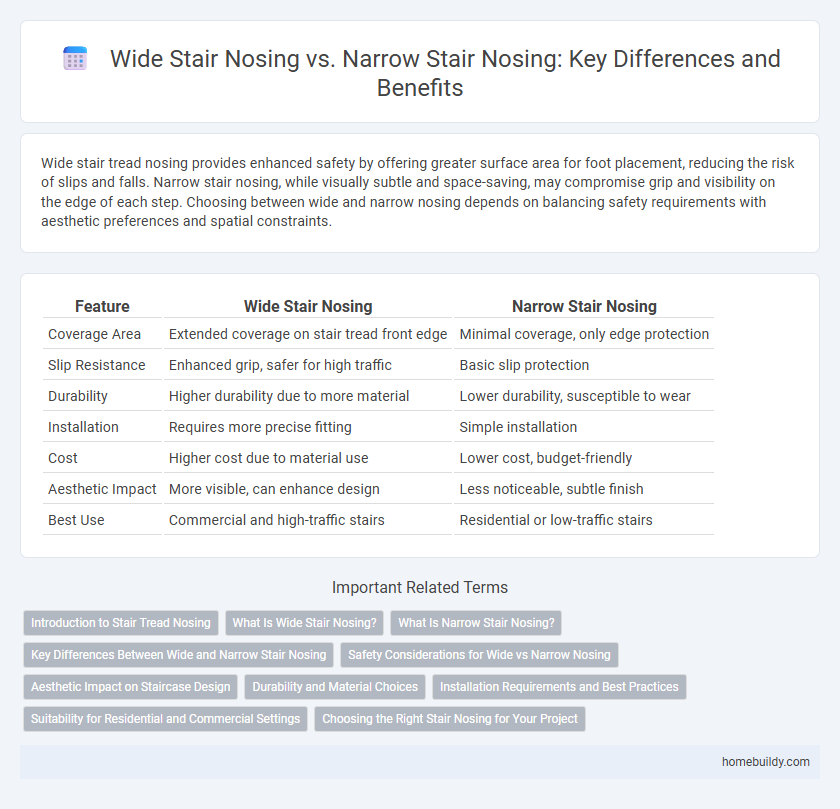Wide stair tread nosing provides enhanced safety by offering greater surface area for foot placement, reducing the risk of slips and falls. Narrow stair nosing, while visually subtle and space-saving, may compromise grip and visibility on the edge of each step. Choosing between wide and narrow nosing depends on balancing safety requirements with aesthetic preferences and spatial constraints.
Table of Comparison
| Feature | Wide Stair Nosing | Narrow Stair Nosing |
|---|---|---|
| Coverage Area | Extended coverage on stair tread front edge | Minimal coverage, only edge protection |
| Slip Resistance | Enhanced grip, safer for high traffic | Basic slip protection |
| Durability | Higher durability due to more material | Lower durability, susceptible to wear |
| Installation | Requires more precise fitting | Simple installation |
| Cost | Higher cost due to material use | Lower cost, budget-friendly |
| Aesthetic Impact | More visible, can enhance design | Less noticeable, subtle finish |
| Best Use | Commercial and high-traffic stairs | Residential or low-traffic stairs |
Introduction to Stair Tread Nosing
Stair tread nosing enhances safety by providing extra grip and visibility at the edge of each step, reducing the risk of slips and falls. Wide stair nosing offers greater surface area for improved traction and durability, making it ideal for high-traffic areas. Narrow stair nosing provides a minimalist look with subtle edge protection, suitable for residential or low-traffic applications.
What Is Wide Stair Nosing?
Wide stair nosing is a type of stair tread nosing designed with an extended width that provides enhanced surface area for improved safety and durability. It helps reduce trip hazards by offering better visibility and additional space for foot placement on each step, commonly used in commercial and high-traffic staircases. This design also protects the edge of the stair tread from wear and impacts, extending the lifespan of the stairs.
What Is Narrow Stair Nosing?
Narrow stair nosing refers to stair tread edging that typically ranges from 1 to 2 inches in width, designed to provide subtle protection and enhanced safety on stair edges. It offers a discreet finish ideal for narrow stairs or minimalist designs while maintaining grip and reducing wear on the tread's front edge. Narrow stair nosing materials include aluminum, rubber, and PVC, chosen for durability and slip resistance in both residential and commercial staircases.
Key Differences Between Wide and Narrow Stair Nosing
Wide stair nosing offers greater surface area, enhancing safety by providing better traction and reducing slip risks, especially in high-traffic areas. Narrow stair nosing is more subtle, preserving the stair's aesthetic and suitable for spaces where minimal design impact is preferred. The choice between wide and narrow nosing depends on balancing visibility, safety requirements, and architectural style.
Safety Considerations for Wide vs Narrow Nosing
Wide stair nosing enhances safety by providing a larger surface area that improves foot traction and reduces the risk of slips and falls, especially in high-traffic or wet environments. Narrow stair nosing offers a minimalist design but may compromise stability due to limited footing space, increasing the likelihood of missteps or accidents. Choosing stair tread nosing width should prioritize user safety by considering expected traffic volume and environmental conditions.
Aesthetic Impact on Staircase Design
Wide stair tread nosing enhances the visual prominence of each step, creating a bold, modern aesthetic that draws attention to the staircase as a key architectural feature. Narrow stair nosing offers a sleek, minimalist appearance, blending seamlessly with the stair tread for a subtle, refined look that complements contemporary design themes. Choosing between wide and narrow stair nosing influences the overall style and perceived spaciousness of the staircase, impacting both functionality and visual harmony in interior design.
Durability and Material Choices
Wide stair tread nosing offers enhanced durability due to its larger surface area, which distributes wear more evenly and resists damage from heavy foot traffic. Common materials for wide nosing include aluminum, PVC, and rubber composites, chosen for their resistance to abrasion and impact. Narrow stair nosing, while less durable under intense use, often utilizes materials like steel and hardwood that provide sufficient strength for lighter traffic areas.
Installation Requirements and Best Practices
Wide stair tread nosing requires precise measurement and surface preparation to ensure secure adhesion and alignment, accommodating potential expansion or contraction in materials. Narrow stair tread nosing demands careful edge finishing and consistent spacing to maintain safety standards and aesthetic uniformity. Both types benefit from anti-slip coatings applied during installation to enhance durability and user safety.
Suitability for Residential and Commercial Settings
Wide stair tread nosing offers enhanced visibility and slip resistance, making it highly suitable for commercial settings with heavy foot traffic and stringent safety regulations. Narrow stair nosing is often preferred in residential environments where design aesthetics and space efficiency are prioritized over maximum durability. Choosing the appropriate nosing width depends on balancing safety requirements with architectural style and usage frequency.
Choosing the Right Stair Nosing for Your Project
Wide stair nosing offers enhanced safety by providing a larger surface area for foot placement, reducing the risk of slips and falls in high-traffic areas. Narrow stair nosing suits compact spaces and aesthetic designs where minimal intrusion is essential, maintaining sleek stair profiles without compromising durability. Selecting the right stair tread nosing depends on the project's safety requirements, spatial constraints, and design preferences to optimize both functionality and visual appeal.
Wide stair nosing vs Narrow stair nosing Infographic

 homebuildy.com
homebuildy.com